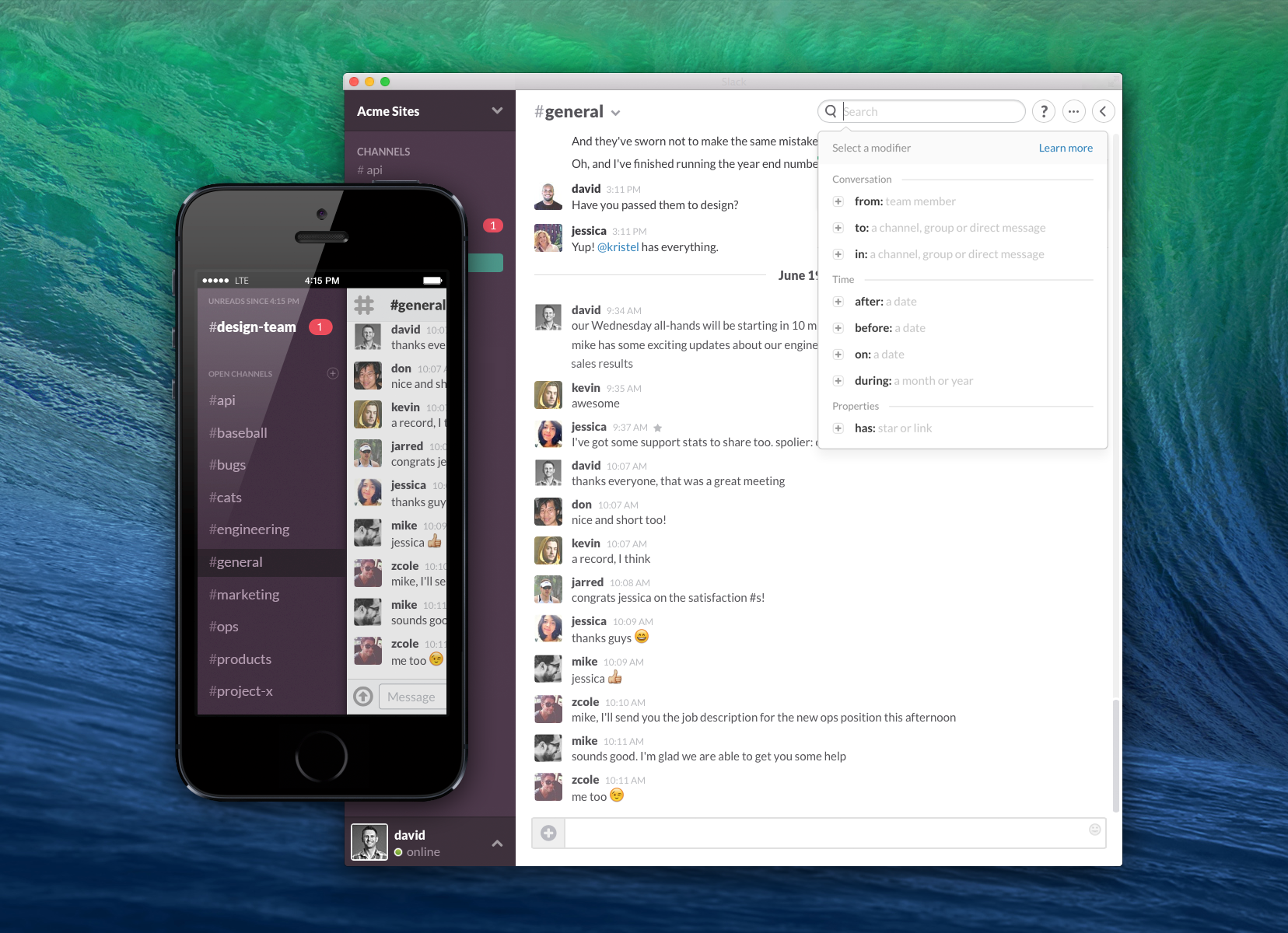Slack path from 0 to $ 1 billion

You either use, or, for certain, already heard about Slack .
And this is not surprising - the company shows a staggering growth in the number of active audiences.
')
Already, more than 30,000 different teams and more than 350000 users use this convenient internal communications platform daily, and the total business valuation reaches $ 1 billion.
You probably have not seen Wall of Love on Twitter, where anyone can express their approval and admiration. Such users, at first skeptical, and later discovering for themselves a great way to communicate in work, are the majority.
At the same time, Slack did not conduct expensive marketing campaigns, did not buy signs in the center of New York, and, in truth, almost did not send advertising messages to the mail. What is the secret?
If any topic slips through the whole story of Slack founder Stewart Buttfield about the product and company paths, it’s one that he concentrated on feedback from users, and based on their suggestions, lined up work and development efforts.
And now Slack entered the acquisitions market by purchasing Screenhero , a startup that emerged from Y Combinator and competed with WebEx. The main functions: providing voice calls and the ability to access the screen of another user to edit files. So far, says Stewart, Screenhero will exist separately and nothing will happen to its existing users until the service is fully integrated with the Slack platform.
With the addition of the Screenhero team, Slack’s total staff has only exceeded 100 employees. These six people from the absorbed project can change Slack beyond recognition, because the news feeds are already full of messages that the audio / video chat and cross-platform PC / MAC access to the screen will soon appear in Slack. Agree - not bad.

In an exclusive interview with Firstround, Stuart Buttfield, CEO of Slack and former co-founder of Flickr, talks about market entry strategies, task prioritization, and customer acquisition.
Slack began work on the product at the end of 2012, and by March 2013, enough was done to begin active testing within the company. In May, Slack opened the service for third-party users, making sure that the platform can be used.
" We begged and begged all our acquaintances and friends working in various companies to try the product and express our opinion to us ." Cozy and Rdio were the first companies to start using Slack in internal communication: “ From six to ten companies joined us due to personal requests .”
Almost immediately after that, Slack engineers realized that the product was scaling well: " The moment of truth was the case with Rdio, whose team was much larger than ours: at first Slack was used only by a small group of developers, but soon all their engineers, and the remaining ones employees began to communicate on our platform - a total of 120 people . "
At the same time, all the imperfections of the product came out, which the staff are now fixing. Armed with this knowledge, Stewart and the team made a number of edits to the original plans and started the process anew, with an even greater number of commands using the platform. By the spring of 2013, Slack was polished, and in August, only 7 months after the start of work, was presented to the public.
" Of course, this was our beta release, but we didn’t call it that because users might have thought the product was raw or unreliable ." Instead, the Stewart team has adopted the “press-blitz” technique, which says that you should use the user engagement tools that you are good at working with. On the first day, 8,000 users registered with Slack, two weeks later, their number increased to 15,000.
The first lesson learned was associated with a typical underestimation of the strength of traditional media, accompanied by a launch. Stewart says that you need to concentrate on this first, starting the communication months before the product’s release and continuing it weeks after the start: “ Pull all the available strings. Work with your PR department or external company to find your own” hook "- it can be anything, from your employees to your customers and investors ."
More importantly, the media story does not end at the moment when the text is published by any publication. Stewart believes that this is only 20% of the overall success recipe: " The remaining 80% are people discussing this news. I almost never go to news sites - there are too many content, but I pay attention to what they choose and what sharing my friends and acquaintances . "
Social media has made the playing field wider, so you have to run around with what you have, which means - take any link and send it further, expand the audience circle with your own contacts.
Explain to users why they need your product?
Here is another interesting point of Slack's early experience - no matter what stage of development (Alpha / Beta) you are in, as you talk about and manage it, it will determine everything that happens to the product in the future. Squeeze every drop of feedback that you can, during this time.
Slack squeezed the maximum, giving the opportunity to test the service and see what he is all about, long before he publicly announced it. It cannot be said that it was originally conceived, rather, it turned out intuitively: “ By August 2013, when we announced the“ opening ”of the platform, we did not have such feedback as now, because we were only 7 months developing a fairly complex product ” .
The greatest challenge for Slack was the experience of selling the product to teams and companies, not just singles: " For most companies, it is usually more difficult to reverse the transition - from a company to a single user who is motivated to switch to platform usage not only at work ." You can compare it with Dropbox, which, after a couple of first uses, is not difficult to convince the user to pay a couple of bucks for the increased disk space. Slack needed to convince a company consisting of many individual elements to implement the tool where changes are usually reluctant to accept the work.
The main risk, in the case of Slack, is that the risk of rejection of the service is multiplied - this means that if one of the members of a team / company refuses to use the platform, then most likely the whole company will refuse it.
Engineers and Slack managers struggled to solve this problem during the beta period: " We created a huge amount of material to explain the advantage of using Slack to any user, to tell how it works. We should also mention team administrators - those who creates spaces for communication. Our main goal was to give these people all the necessary ammunition in order to convince them to switch to Slack . "
Since intracorporate communications is a relatively new field of business, it is difficult to separate product use learning from learning how to market such products. Stewart says: “ Between 20% and 30% of our users, and this is just a rough estimate, comes from other centralized communication systems, such as HipChat, Campfire and IRC. When we learned about this, we asked the remaining 75% what they used for internal communications, the answer was prosaic: “ Nothing .” But, of course, this is also not completely correct - everyone uses some tools, even if it is a post, just no one appreciates it in this product category. ”
When Stewart, out of innate curiosity, got to understand what exactly “nothing” was used by companies registering with Slack from scratch (without previous experience of similar projects), he quickly found out that, in fact, a huge number of different services were used and their number, total incompatibility with each other, and forcing users to say that “there is nothing”: “ These services simply did not constitute a single platform: people used everything from Hangouts, to SMS, Skype, or even closed Facebook groups and pages Go ogle + ".
Hence, the following conclusion: “ If you are innovating in a very fresh market, make your product understandable, and its fundamental differences from competitors and all the best places are obvious, this should be the core of your market entry strategy, because even just a list of the “Benefits of such a service” is itself capable of generating sales .
And this is what Stewart says about product positioning for “teams”, rather than entire companies, in which there are often several such teams: “ For small organizations, it may turn out that“ team = company ”, but if you look at the example of a corporation with 15 000 employees, you will find yourself in the situation of Adobe, which supports nine different Slack teams. Moreover, the “conversion hole” (loophole) discovered in this way allowed Slack to grow quickly and efficiently in terms of the number of users, because any manager or even a mid-level engineer could say "Oh, cool stuff", and these are beginning to enjoy his colleagues - do not need any centralized procurement or payment for services. "
This factor contributed to the primary success of Slack in a corporate environment: “ We made it so that it was easy to join the platform, and the process was as pleasant as possible. No one wants to agree on a lot of small things, so we just made it so that people can use the service, first of all, and leave the red tape for later or not engage in it at all . "
User training turned out to be a useful thing: " From August 2013 to February 2014, we went through the first 15,000 registrations and more than half of them gave us an understanding of what the Slack user needs, thanks to which we were able to grow a product that everyone likes and is easily accessible ."
Working with feedback, opinions and problems of the user is at the core of Slack's organizational processes, because the team developing the platform learns from users not less, and perhaps even more, than they hear from them about how the product works. “ Sometimes, ” says Stewart, “ we received feedback, which is fundamentally at odds with our product vision. At the same time, you can try to dive in a direction that you don’t even understand to the beginning. Therefore, from the very beginning, we followed the first users - and in fact testers of our service, among companies that, as we knew, had to use the platform correctly and efficiently . "
When one of these key users wrote that something was not working or was displayed incorrectly, we instantly repaired it and made corrections.
An example of such an action can be demonstrated on the “channels” that are created within each project in Slack — they can be created in any quantity, and very quickly a problem arose when, for example, the new employees of a company simply could not understand what of which they must join, and which ones must be ignored. The Slack team quickly saw this problem and changed the organization of the channels so that you can quickly read its description and see the number of participants in each of them, individually. The example is simple, but indicative - to do the most obvious, simplifying the lives of users, and everyone will be satisfied.
The Slackback feedback in numbers is now as follows: 8,000 Zendesk tickets and 10,000 tweets per month. The guys are still trying, and they have time, to process all requests, although at first it was rather hard, especially until quietly until only two people did it - Stewart dealt with requests from Twitter, and the director of quality and support, Ali Reil, was busy Zendesk. Now, of course, the staff of people for these tasks has expanded significantly, because Slack still considers the opinion of its users to be the main driver of development: 18 people, of whom 6 monitor Twitter, 24/7, without exaggeration.
You can independently write a tweet in @SlackHQ in order to feel how quickly and efficiently the service works with feedback from this channel. This is not only support - the user’s successfully resolved problem diverges from him in a network way to his contacts, enhancing the marketing effect that was not originally planned at all.
From here and the following general remark of Stewart - each client and each interaction with him gives practical unlimited opportunities for product marketing. If you solve his problem after a personal appeal, he is most likely to recommend you to all his acquaintances.
Naturally, Slack also ensures that all user requests are systematized - the features offered by the audience are sorted by the number of the largest mentions, etc. This allows you to plan work on improving the platform only on the basis of how teams use Slack - the best indicator of what is happening.
" Know your numbers well " - one more advice from Stewart. “ In Slack, our“ magic number ”is 2000. These are two thousand messages. In our experience, the team generates 2000 messages in about 10 hours of continuous communication, and this is a team of 50 people. For a team of 10 people, this will be a whole week communication. In any case, the important thing is that the team that exchanged these 2000 messages within Slack remains with us in the future. Only 7% of organizations that have exceeded this threshold have finally refused to use Slack . "
“ You need to be well aware of what conversion means and returning a user in average numbers and projects, you should know what these concepts mean personally for you and your project, ” says Stewart. Different products dictate different rules and mechanics of working with these concepts. Since Slack is aware of their “two thousand” and magical meaning of this figure, they are able to orient themselves towards it when planning further improvements to the platform.

But, in any case, at the root of any feedback, there is a product that you make. And if you do it well, you know what exactly makes it popular: " We set very high benchmarks for ourselves, and we will not be internally satisfied until we reach them ."
Here, Stewart cites as an example the recent publication of Paul Bukkhayta with the title: " If your product is great, it does not need to become good ." Buckhite is known as one of the co-founders of Gmail, and his thesis is quite simple: if you do an excellent job with one or two tasks on any scale, the rest, in general, is not that important. Gmail as an example - for a long time there was nothing in it except searching by letters, branching correspondence and, at that time, almost fantastic 1 GB of space, but users did not think about “what is not in Gmail” - they were amazed what is in it.
" We do not intend to cut corners and we concentrate on what we consider really important ."
In Slack, these things are not so much.
Search For Slack, searching is just as important as for Gmail - having many channels of active correspondence, people want to quickly access the necessary information. The user should not worry about the fact that he did not save any document - he should get access to it at any time.
Sync . Regardless of where and how you use Slack, your channels will always be synchronized between devices. You do not miss anything, and all the information will reach you, on the desktop, or on your smartphone.
Simple file sharing . Slack solved the problem of documents and sharing them in the easiest way - you simply drag and drop any file and it becomes immediately accessible to everyone. No matter where from - from the local machine, from a corporate Dropbox account or some third-party service, this file will still be visible in the channel to other users.
" We argued for a long time about what to consider as the three pillars of Slack, on which we build the entire platform and on which we concentrate maximum of our attention. Finally, these three aforementioned goals resonated with each of us - this is really what unites us and ours users around Slack. It may sound too simple, or even naive, but when you enter a competitive market, you have to rely on something, being sure that you are not mistaken. Apparently, we were not mistaken because the impression that it is these tr and things and allowed us to be ahead of competitors in the new market, where the rules of conduct are still completely incomprehensible to anyone . "
Source: https://habr.com/ru/post/283886/
All Articles